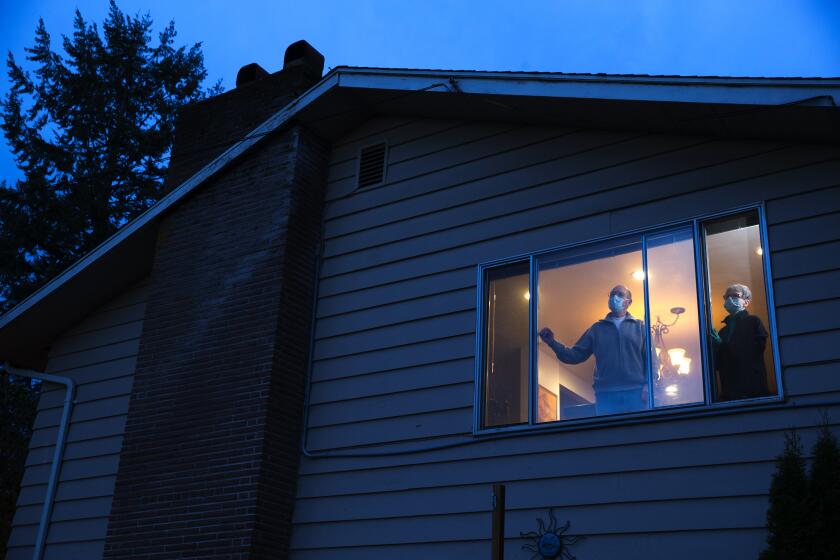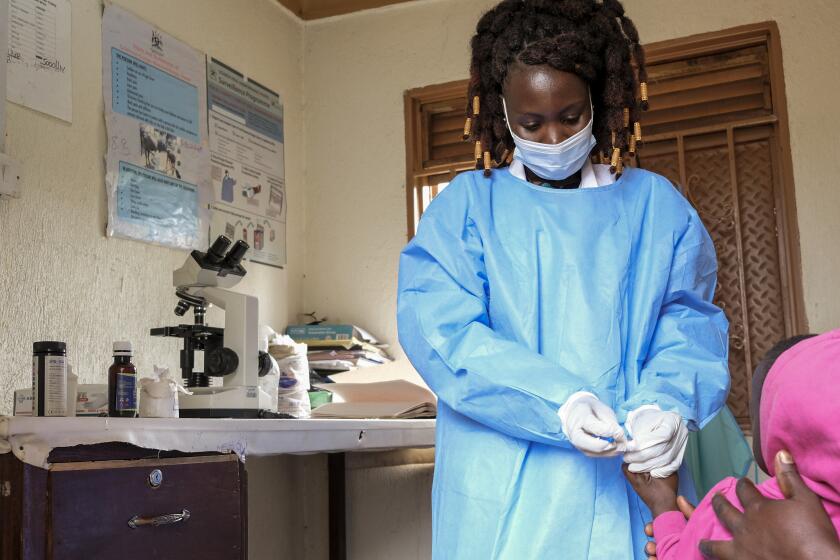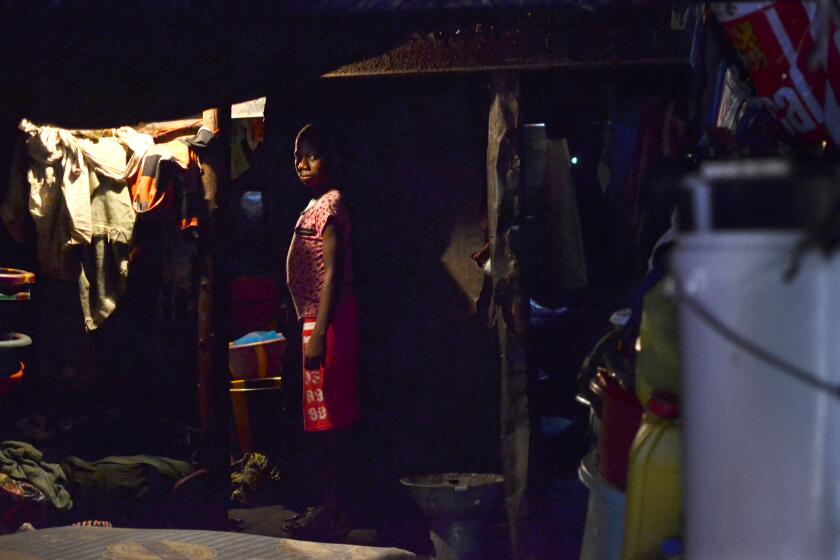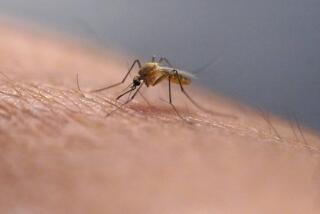Ebola outbreak in Uganda puts California doctors on alert
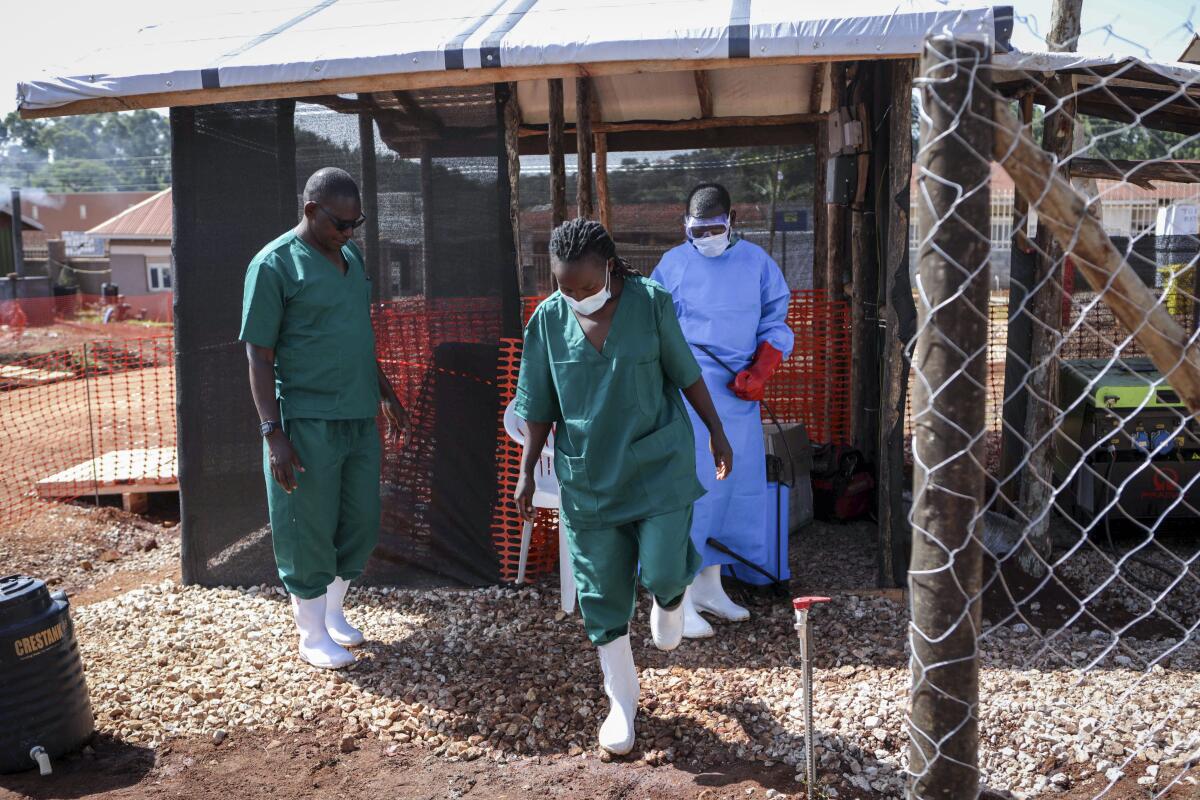
- Share via
California officials are urging doctors to be on alert for any signs of Ebola symptoms among people who have recently traveled to Uganda, the East African nation currently undergoing a significant outbreak.
So far, the Ebola outbreak in Uganda has been limited to rural areas of that East African country. Ebola cases have not been reported in Uganda’s capital, Kampala, nor Entebbe, home to the nation’s international airport, according to a recent bulletin by the California Department of Public Health.
“However, spread of the outbreak within the region is possible due to several factors,” the report said. They include the likelihood that Ebola was spreading weeks before the index case was identified and that patients initially sought care at healthcare facilities with sub-optimal infection-control practices.
In addition, some of the early victims were buried in large ceremonies, and the area where the outbreak began was along a main highway two hours from the Ugandan capital and leading to the Democratic Republic of Congo.
Many experts believe that this surge in new infectious diseases is being driven in part by some of humanity’s most environmentally destructive practices.
There are 54 confirmed and 20 probable Ebola cases in the recent outbreak, as well as 39 deaths, according to the World Health Organization. An outbreak was declared Sept. 20. The Ebola strain behind this outbreak is known as the Sudan species; past outbreaks of the Sudan species have resulted in a mortality rate of 50%.
There are no vaccines or drugs approved to prevent or treat the Ebola Sudan species. The current Ebola vaccine is designed for use against the Ebola Zaire species and isn’t expected to protect against the Ebola Sudan species, according to California health officials.
On Oct. 6, federal officials began routing all U.S.-bound passengers who have been in Uganda in the 21 days before arrival through one of five airports: John F. Kennedy International Airport in New York, Newark Liberty International Airport in New Jersey, Hartsfield-Jackson Atlanta International Airport, Chicago O’Hare International Airport and Washington Dulles International Airport.
Travelers at those airports will be checked for symptoms by the U.S. Centers for Disease Control and Prevention. Those who show no symptoms will be allowed to continue to their final destination. Those coming to Los Angeles County as their final destination will be referred to the Los Angeles County Department of Public Health for ongoing monitoring, local health officials said.
Once they arrive in L.A. County, the local Department of Public Health will give travelers information to monitor symptoms, and they will be given a phone number to call a nurse with the county should they have questions or begin to experience symptoms.
It can take 21 days between exposure to the virus for the onset of symptoms to begin.
Africa must plan to respond to outbreaks without outside help, a top health official said, warning that the continent is ‘on its own’ during pandemics.
No Ebola cases have been reported in the U.S., the California Department of Public Health said. But state officials and infectious diseases experts told doctors to be on the lookout for symptoms consistent with Ebola virus infection among people who have traveled recently to Uganda.
“So just to remind you what to watch out for: fever, fatigue, muscle pain, headache, sore throat, and it’s followed by vomiting and diarrhea and bleeding from gums, et cetera, but not in everyone,” UC San Francisco infectious diseases expert Dr. Peter Chin-Hong recently told his colleagues in a campus town hall meeting. “So far, not a concern in the U.S., but again, something we’re watching really closely.”
During the 2014–16 Ebola outbreak, centered in West Africa and caused by the Ebola Zaire species, 11 people in the U.S. were treated for the virus. Of the 11, two died — both of whom had been in West Africa.
The 2014–16 Ebola epidemic — the largest since Ebola was discovered in 1976 — resulted in more than 28,000 cases and 11,000 deaths, mostly in Liberia, Sierra Leone and Guinea.
Ebola is generally transmitted through direct contact with blood and other bodily fluids — including saliva, sweat and vomit — from someone who is sick or who has died from the virus. It is not spread through air, food or water.
A reporter who covered an Ebola outbreak in West Africa discovers troubling parallels in the U.S. over the coronavirus, including conspiracy theories and denial.
People can spread the Ebola virus only after developing symptoms of illness.
“Ebola poses little risk to travelers or the general public who have not cared for or been in close contact (within three feet or one meter) with someone sick with Ebola,” the U.S. Centers for Disease Control and Prevention said.
During an Ebola outbreak, however, the virus “can spread quickly within healthcare settings,” the CDC added.
L.A. County is prepared for Ebola cases should they arrive locally, Public Health Director Barbara Ferrer said.
The county has the capability to test for Ebola virus and is home to an Ebola regional treatment center. In 2016, Cedars-Sinai Medical Center in Los Angeles was designated a regional Ebola treatment center, meaning it has agreed to accept Ebola patients from elsewhere in California, as well as Arizona, Nevada, Hawaii and U.S. territories in the Pacific Ocean.
Other hospitals in California that can care for patients with Ebola, according to a state news release in 2016, include Ronald Reagan UCLA Medical Center in Westwood, UC Irvine Medical Center, UC San Diego Medical Center, UC San Francisco Medical Center, UC Davis Medical Center, and Kaiser hospitals in Los Angeles, Oakland and Sacramento.
More to Read
Sign up for Essential California
The most important California stories and recommendations in your inbox every morning.
You may occasionally receive promotional content from the Los Angeles Times.
